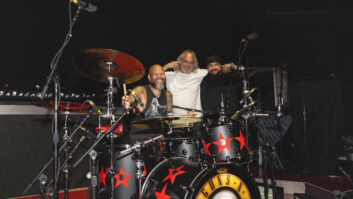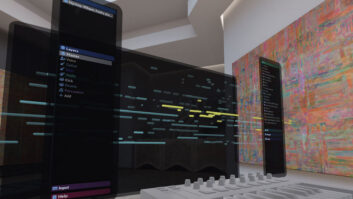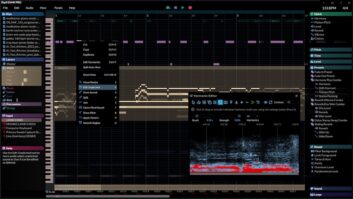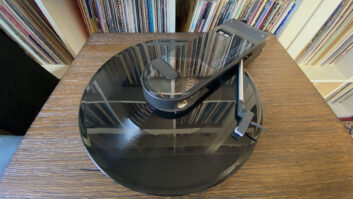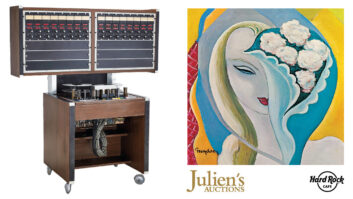The long-awaited third season of The Sopranos debuted March 4, airing back-to-back episodes of the acclaimed HBO series that depicts the complicated life of a modern day New Jersey crime boss who just can’t get no satisfaction. In a show where there’s something for almost everyone, protagonist Tony Soprano faces problems with his nuclear family, his crime family, and even with his psychiatrist, as he tries to reconcile the multiple roles of Mafia don, husband, father, son, lover and hapless victim of modern life. Weighted with cool music, funky East Coast dialog and real-life issues, The Sopranos is a hybrid between television and film, presented in an over-the-top fashion that somehow, like all art at its best, becomes more real than real.
Key to creating the atmosphere of any show is, of course, the soundtrack, and boldly, The Sopranos employs no music composer. Instead, dialog, atmosphere and licensed music interweave to portray the multiple psychological and emotional landscapes that make up each episode.
In January, Mix dropped in at Stage 3 at Todd Studios West, a division of Livewire Audio located in West Los Angeles, where another Soprano family, namely the production team, was hard at work. Headed up by producer Martin Bruestle, the crew, many of whom have worked together since 1999’s pilot, really do seem to be a family. Having spent the previous two seasons together, they’re now working harder than ever on a show that has proven to be not only a hit, but a critical favorite with a fan subculture all its own.
A single viewing of The Sopranos quickly reveals one of its most striking production elements: the large number of scenes in each episode. Since it airs on HBO, it is commercial-less, a fact that adds approximately 10 minutes to each show. But, as any fan will attest, in addition to those extra minutes there’s just a whole lot going on. “Our first episode this year has 104 scenes,” comments Bruestle. “People wonder why we’re not on until March, but HBO really does take the time to allow us to get what we have to.”
The Sopranos very much continues to be the vision of creator and executive producer David Chase. “David supervises from the script to the final mix,” Bruestle says. “He’s very sound-savvy, and very involved with selecting the music, along with me and music editor Kathy Dayak. We don’t ship the show to HBO until we play the final mix back for him. Often he’ll even come up with ideas on the mixing stage.”
SOUND AS AN EQUAL PARTNER
Both Bruestle and Dayak previously worked with Chase on television’s Northern Exposure, a series known for its hip selection of music. “I really believe that sound is 50 percent of filmmaking,” Bruestle continues. “You see the picture, but you feel the sound. Sound can take something simple and make it extraordinary, and affect people in ways that they don’t even realize. Sopranos is unique in that it doesn’t employ a composer. Instead, all music in the show is licensed, and that dictates a different approach. What we do here is to try to be creative with sound without being gimmicky.”
Sopranos is shot on soundstages in Long Island City and in multiple locations throughout New Jersey. “I start on the shows when we do the sound spot with the film editor, the assistant film editor and Anna MacKenzie, the supervising sound editor,” explains Bruestle. “We first look at the shows without any music. David likes to look at the shows that way so that he can work on how the story tracks throughout an episode. Gradually, as he’s refining the editing, we’ll start incorporating music. On this show we don’t really have formal music spotting; instead, as we’re putting it together, we start to feel where music can live.”
The absence of traditional underscore in Sopranos seems to endow the music that does become part of the show with extra impact. “The writing is so good that it lets moments play without analyzing where the dramatic beat is,” Bruestle says. “Because we’re on HBO and don’t have commercial breaks, we don’t have to create those artificial, act-out-into-commercial moments. We’re not committed to having to play themes for characters, or to lead up into commercial; there isn’t a format that we have to follow. Instead, we have to create the reality, or unreality, of each character. Sometimes we use different genres of music for that. For example, we had a lot of fun last year with [wife] Carmella [Soprano] always listening to Andrea Bocelli, and then we’d cut to [strip club] the [Bada] Bing, where they’re playing something completely different by a band like Bitch Funky Sex Machine or Metallica.
“Generally, we’ve spent a good deal of time before we get to the dub stage thinking about the music, trying different songs and running things by David,” Bruestle continues. “And hopefully they’re approved and placed so that we’re ready to go with music at the dub stage, except for affecting it with room sound and whatever else we might need to add or subtract from the cue to make it work within the scene. But things can, and do, change on the dub stage.”
FOLEY, ADR, BGS
Heavy use of Foley and ADR differentiates Sopranos from standard television, as does the fact that there may be picture changes right up until, and during, the mix. “The show is treated like a feature in every aspect except for maybe the time that we get to do it,” says supervising sound editor Anna MacKenzie with a laugh. “ADR is extremely important in this show. Often there are a lot of changes and rewrites in dialog that we have to cover with ADR, even on camera lines, which of course makes for more complicated editing.”
Sopranos’ reality style dictates heavy use of profanity that also makes for more ADR; a “TV” version of the soundtrack must be made that uses replacement dialog for all taboo words. “The TV version hasn’t been used yet,” MacKenzie notes, “But the HBO delivery requirements are such that we have to prepare for it. We spot and shoot alternatives for each scene — that definitely adds to the ADR.”
The amount of work required to create backgrounds for 104 scenes is, obviously, extensive. Over the last two seasons a library has been built to cover the basics of the familiar sets, such as the Soprano house and the cavernous and sonically complicated Bada Bing, where scenes shift from the bar and stage area to the upstairs office, with concurrent switches in the sound and music. But there are always new locations, such as the cemetery funeral scene in the season opener, complete with cranking casket and train-bys. “Not only do the locations change,” MacKenzie continues, “but, depending on the episode and what mood we want to create, we will change backgrounds and effects, even in familiar, recurring locations.”
All source material except music, which is on DA-88, is delivered to the dub stage on hard drives. Effects are on Pro Tools; dialog, Foley and ADR are on Fairlight.
FILM-STYLE MIX
Generally, a Sopranos mix takes three days, two for mixing and one for playback, fixes and printmastering, with mixes being sent for approval via ISDN to Chase, who remains on the East Coast until shooting wraps. The 2001 season was mixed in 5.1 surround on Todd West’s Otari Premiere console using DiskMix automation. Three mixers dub each show: Lead mixer Kevin Burns, on dialog and Todd Orr on effects have been with the show since the pilot, while Fred Tator, music and Foley, came onboard this year.
According to Burns, an average scene will contain 24 dialog tracks; eight each of production dialog, ADR and loop group. It helps that each fader of the 72-input Premiere has two switchable line sources; if there are more tracks needed than faders available, an A/B switch provides access. Although the show doesn’t air in 5.1 yet, that format is currently used for the DVD versions. Twenty-two channels worth of stems are used to create the 5.1 mix, which is then dubbed to a 2-channel printmaster. Why 22? “We only have 24 buses on the console,” Burns explains. “I use two of them as reassigns for outboard processing for my dialog and ADR, leaving 22 channels that we can bus to.
Sopranos is unique in that it doesn’t employ a composer. Instead, all music in the show is licensed, and that dictates a different approach. What we do here is to try to be creative with sound without being gimmicky.
— Martin Bruestle
Dialog and music/Foley each use six channels for the 5.1 mix, effects uses seven. The three remaining channels include a center, used for production effects or sounds recorded on the dubbing stage, a mono dialog stem and a mono principal ADR stem. “That gives me some flexibility by keeping the production dialog and the ADR separated from group and reverb,” Burns explains. “If I have to go in and do fixes, I can do it more efficiently.”
Dialog tracks delivered to Burns on the stage are the original recording with no premixing. Tools he uses to clean, match and add appropriate ambiences to the tracks include Dolby Cat 430s for noise suppression, GML parametric EQ and a Lexicon 480L. “The dialog editor does a great job of preparing the tracks for the mix,” he notes.
A favorite effects box, purchased at a pawn shop, is the Metal Machine. “It’s an inexpensive guitar distortion box that has some EQ,” Burns comments. “On Sopranos I’ve used it a lot in the surveillance scenes, when someone is wearing a wire, to get it to break up. A lot of the new gear will distort but doesn’t sound as ragged or authentic, so I use the Metal Machine and a gate to get distortion and to get the track to cut in and out randomly.”
Effects mixer Orr agrees that developing atmospheres is one of the main sonic challenges of the show. “There’s always a new location that needs a new atmosphere,” he says. “The music playing in the scene does, in a way, score it, but it always works with the backgrounds — the walla, the clinking if they’re in a restaurant, things like that.
“We want a realistic atmosphere that works dramatically with what’s happening in the scene, but that doesn’t overdo it,” he adds. “For example, the way I mix hits and punches when somebody is getting beaten up; I try to make it realistic instead of over the top.”
Orr usually works with 24 to 32 tracks of sound effects played back from a 32-track Pro Tools system. His main effects box for reverb and room sound is also a Lexicon 480L, and he uses an Eventide Orville for sampling and pitch-shifting. “Brian Risner, who does the sound effects, is doing a really great job,” Orr notes. “Like in the cemetery scene, where he gave me four different tracks for the coffin lowering. That enables me to play it any way I want to, and any way the producers ask me to.”
Production sound effects get heavy usage on Sopranos. “The production recording is excellent on this show,” Orr continues. “Matthew Price really takes a lot of care in recording it, so we save and use as much of the PFX as we can. Kevin [Burns] and I work together on that, using a separate center channel that gets blended with my regular center channel in the printmaster.”
WEAVING THE TAPESTRY
Fred Tator is generally mixing eight tracks of music from DA-88s, along with eight to 14 tracks of Foley, also relying on a Lexicon 480L for reverb, along with an Eventide DSP 4000 for delays and effects. “This show does require that you ‘work’ the Foley a little bit more than some others,” Tator says. “It’s not just there for coverage on the M&Es for the foreigns, it actually is integral to the show. The trick with Foley, of course, is to make it so you don’t notice it’s playing. It has to fit in very well. Also, this show is mixed to a widescreen format, and care has to be taken to make sure that those things that appear on widescreen format don’t stick out when you’re in the 4×3 format. We mix to the widescreen, but we reference to the smaller screen and make whatever adjustments are necessary.”
Tator cites the cemetery setting in one of the season openers as an example of how many Foley elements might play in a scene. “While the dialog is happening, there are people walking in the background throwing dirt on the coffin; those sounds need to be in a position where they fit in with the background sound, along with other people walking by and the FBI surveillance team that’s watching from behind a fence above the road. All the movements need to be differentiated; you’re hearing them all at once, but they can’t appear to be coming from the wrong place. Some of that is in the panning, some of it’s in EQ — dulling up some sounds, making others more present. And some of it is where it fits into the mix — whether it sounds a little distant or closer — which is done with different reverb settings.
“When it’s right, the sound works together like a tapestry,” he continues. “If you look really close, you can see the stitching and the separate colors, but when you stand back, the individual pieces don’t stand out because the whole thing just fits together.”
Upon approval by Chase, the 2-track printmaster is made through a Dolby DS4 matrix and, new this season, recorded onto a Tascam MMR8. “Since we’re mixing in 5.1, we’re not really hearing what will be broadcast,” Burns notes, “because that will only have a mono surround. So when we play back for Martin and David, we do it on small speakers through the matrix. That gives us a chance to see how what we’ve done will translate to the Lt-Rt. With the hard drive we can record it all as one file, which is nice for the playback, because we can view the whole show nonstop; we get to see it all together.”
Producing the soundtracks for a Sopranos’ season is definitely a full-time job — it takes most of a year to complete the 13 episodes. For 2001’s season, filming started in August, with the last show scheduled to be delivered in May, and preparation for the next season starting up again in July. There are a lot of long days in those months, but nobody on the team seems to be complaining,
“Working on The Sopranos is creatively very satisfying on multiple levels,” concludes Bruestle, “starting with the freedom given us by HBO. And also, we all really love the show. Everyone who works on it has a lot of the same tastes, and it really is a lot like a family.”

